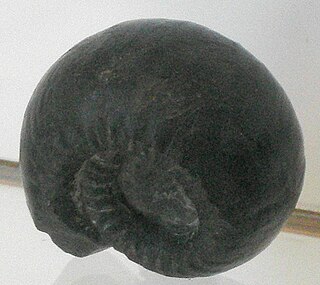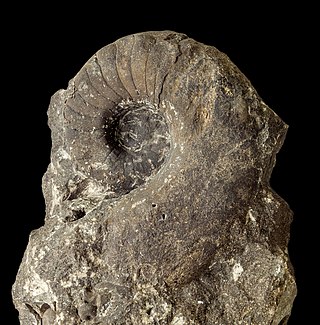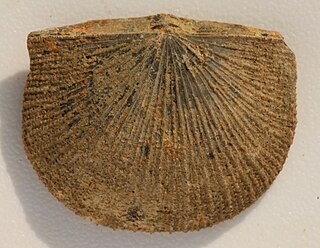
Craniata is a class of brachiopods originating in the Cambrian period and still extant today. It is the only class within the subphylum Craniiformea, one of three major subphyla of brachiopods alongside linguliforms and rhynchonelliforms. Craniata is divided into three orders: the extinct Craniopsida and Trimerellida, and the living Craniida, which provides most information on their biology. Living members of the class have shells which are composed of calcite, though some extinct forms my have aragonite shells. The shells are inarticulate and are usually rounded in outline. There is no pedicle; the rear edge of the body cavity is a smooth and flat wall perforated by the anus. This class of brachiopods has an unsupported lophophore with only a single row of tentacles. In the absence of a pedicle, the shell is usually attached directly to a hard substrate. Many craniiforms are encrusting animals which attach directly to the shell of another animal, usually another brachiopod. The plicae from the host brachiopod will then appear within the shell of the craniiform.
Huronia is an actinocerid genus included in the Huroniidae along with Discoactinoceras and Huroniella,(Teichert 1964). Huronia is characterized by long siphuncle segments with the free part of the connecting rings only slightly inflated and by a narrow central canal and strongly curved radial canals located in the anterior part of each siphuncle segment

Gastrioceratoidea is one of 17 superfamilies in the suborder Goniatitina, ammonoid cephalopods from the Late Paleozoic.
Actinoceras is the principal and root genus of the Actinoceratidae, a major family in the Actinocerida, that lived during the Middle and Late Ordovician. It is an extinct genus of nautiloid cephalopod that thrived in the warm waters of the United States and England during the Paleozoic era.
Lambeoceras is a genus of large actinocerids with a convexly lenticular cross section from the Upper Ordovician of North America and the sole representative of the family Lambeoceratidae.

Strophomenida is an extinct order of articulate brachiopods which lived from the lower Ordovician period to the mid Carboniferous period. Strophomenida is part of the extinct class Strophomenata, and was the largest known order of brachiopods, encompassing over 400 genera. Some of the largest and heaviest known brachiopod species belong to this class. Strophomenids were among the most diverse and abundant brachiopods during the Ordovician, but their diversity was strongly impacted at the Late Ordovician mass extinction. Survivors rediversified into new morphologies in the Silurian, only to be impacted once again at the Late Devonian mass extinction. However, they still survived till the end of the Permian.
Stearoceras is an extinct genus of prehistoric nautiloids from the Lower Pennsylvanian - Lower Permian with a fair worldwide distribution.(Kümmel 1964)
The Actinoceriatidae are a family of actinocerids named by Saemann in 1853 for those that grew to have large shells with blunt apices and large siphuncles with widely expanded segments and a generally arcuate endosiphucular canal system. Their range is from the upper Middle Ordovician to the Lower Silurian. Actinocerids are generally straight-shelled nautiloid cephalopods with a siphuncle composed of expanded segments, typically with thin connecting rings, in which the internal deposits are penetrated by a system of canals

The Armenoceratidae are a family of early Paleozoic nautiloid cephalopods belonging to the order Actinocerida.
Wutinoceras is a genus of now extinct nautiloid cephalopods of the Wutinoceratidae family. It exhibits orthoconic actinocerids with ventral siphuncles composed of broadly expanded segments.

Rhynchonelliformea is a major subphylum and clade of brachiopods. It is roughly equivalent to the former class Articulata, which was used previously in brachiopod taxonomy up until the 1990s. These so-called articulated brachiopods have many anatomical differences relative to "inarticulate" brachiopods of the subphyla Linguliformea and Craniformea. Articulates have hard calcium carbonate shells with tongue-and-groove hinge articulations and separate sets of simple opening and closing muscles.
Saffordoceras is an actinoceratid from the Middle Ordovician, found in eastern North America, characterized by a flattened venter; sutures with broad, deep ventral lobes and narrow lateral saddles; and subventral siphuncle with segments decreasing from about 0.3 to less than 0.2 the shell diameter. Saffordoceras is probably derived from Actinoceras. Related contemporary genera include Paractinoceras and Troostoceras

Metacoceras is a nautilitoid cephalopod from the Upper Carboniferous (Pennsylvanian) and Permian, the shell of which is moderately evolute with a subquadrate whorl section, bearing nodes on the ventral or umbilical shoulders or both, but otherwise smooth. The siphuncle is small, subcentral and orthochoanitic. The suture has shallow ventral and lateral lobes but no dorsal or annular lobe.
Kochoceras is an extinct nautiloid genus from the later Ordovician belonging to the family Actinoceratidae and found in North America.
Actinomorpha is a genus of valcouroceratid, order Oncocerida, from the Middle Ordovician of central North America, named by Rousseau Flower, 1943. The shell is breviconic, short and laterally compressed; the venter more narrowly rounded than the dorsum, having the effect of a modest keel in horizontal orientation. The shell is gibbous adorally, such that the body chamber is widest well behind the aperture. The siphuncle is ventral, which could also be indicative of a horizontal orientation in life, with broad, slightly inflated segments and continuous, radial, actinosiphonate, deposits.

Paterinata is an extinct class of linguliform brachiopods which lived from the lower Cambrian ("Tommotian") to the Upper Ordovician (Hirnantian). It contains the single order Paterinida and the subfamily Paterinoidea. Despite being some of the earliest brachiopods to appear in the fossil record, paterinides stayed as a relatively subdued and low-diversity group even as other brachiopods diversified later in the Cambrian and Ordovician. Paterinides are notable for their high degree of convergent evolution with rhynchonelliform (articulate) brachiopods, which have a similar set of muscles and hinge-adjacent structures.
Leurorthoceras is a genus of flattened actinoceratids with a siphuncle narrower than in Actinoceras, segments of which tend to become longer in the mature parts of the phragmocone, the chambered part of the shell. This fossil is known from the Middle Ordovician of North America, Europe, and Siberia.
Paractinoceras is a genus of long, straight, and slender actinocerid nautiloid with siphuncular segments in the early stages like those of Actinoceras, becoming narrower in the later stages of the chambered phragmocone like those in Ormoceras. As with Kochoceras and Floweroceras, Paractinoceras is considered a separate genus within the Actinoceratidae, distinct from Actinoceras.

Kutorginates (Kutorginata) are an extinct class of early rhynchonelliform ("articulate") brachiopods. The class contains only a single order, Kutorginida (kutorginides). Kutorginides were among the earliest rhynchonelliforms, restricted to the lower-middle part of the Cambrian Period.

The orthotetides (Orthotetida) are an extinct order of brachiopods in the class Strophomenata. Though not particularly diverse or abundant relative to strophomenides (Strophomenida) or productides (Productida), orthotetides were nevertheless the longest-lasting order of strophomenates, surviving from the Middle Ordovician (“Llanvirn”) up until the Late Permian. Externally, many orthotetides are difficult to distinguish from strophomenides. Most fundamental differences between the two orders are internal: orthotetides have more elaborate cardinal processes and a greater diversity of shell microstructure.







